

Seminar über die Physik der kondensierten Materie (SFB/TRR173 Spin+X und SFB/TR288 Kolloquium, TopDyn-Seminar)
May 15, 2014 at
3:15 p.m. c.t.
in
Minkowski-Raum, 05-119, Staudingerweg 7
Univ-Prof. Dr. Jure Demsar
Univ.-Prof. Dr. Hans-Joachim Elmers
Univ.-Prof. Dr. Mathias Kläui
Univ.-Prof. Dr. Thomas Palberg
Note: (Achtung: Vortrag beginnt um 15.00 Uhr ct.) Ansprechpartner: Herr Elmers
Spin filtered momentum microscopy: An efficient approach to the bandstructure of correlated electron systems
Dr. Christian Tusche (MPI Mikrostrukturphysik Halle)
One of the most fundamental concepts in solid state physics is the description of the motional and energetic degrees of freedom of the electrons by the relation of the energy E vs. the crystal momentum k in a band structure of independent particles. In a real electron system however, exchange- and correlation interaction are collective phenomena. A prototypical system of correlated electrons are the ferromagnets Fe, Ni, and Co, where a description of the electronic bandstructure in the widely used local density approximation (LDA) is of limited use. The fact that well defined electronic bands are not observed experimentally, was attributed to the finite lifetime of the quasi-particle states of the interacting system [1].
An efficient tool for the quantitative understanding of the quasi-particle band structure, even in absence of sharp spectral features, is spin resolved momentum microscopy. A spin polarizing electron mirror [2] allows the simultaneous measurement of the spin polarization of the photoelectrons at every point in the full surface Brillouin zone, for the first time. The spin resolved momentum maps of cobalt show that the intensity at the Fermi surface is dominated by sharp minority bands, in good agreement with theoretical expectations. In contrast, the exchange split majority bands are not observed as distinctly sharp spectral features, but intensity in the majority spin channel is distributed over a wide k|| range. The results support advanced theoretical concepts for the treatment of spin-dependent electron correlation.
Fundamental improvements of the energy- and momentum-resolution of a newly designed "nextgeneration" momentum microscope push this efficient method for complete bandstructure measurements to limits previously only available in the classical angle resolved photoemission spectroscopy.
Simultaneously, spin detection efficiency is largely improved by the use of the Au passivated Ir(100) spin-polarizing electron mirror [3,4]. We are confident that this novel development will stimulate important spin resolved bandstructure studies of correlated electron materials.
[1] J. Sánchez-Barriga; J. Minár; J. Braun; A. Varykhalov; V. Boni; I. Di Marco; O. Rader; V. Bellini; F. Manghi; H. Ebert; M. I. Katsnelson; A. I. Lichtenstein; O. Eriksson; W. Eberhardt; H. A. Dürr and J. Fink: Phys. Rev. B 82, 104414 (2010)
[2] C. Tusche, M. Ellguth, A. Ünal, C.-T. Chiang, A. Winkelmann, A. Krasyuk, M. Hahn, G.
Schönhense and J. Kirschner: Appl. Phys. Lett. 99, 032505 (2011)
[3] J. Kirschner, F. Giebels, H. Gollisch and R. Feder: Phys. Rev. B 88, 125419 (2013)
[4] D. Kutnyakhov, P. Lushchyk, A. Fognini, D. Perriard, M. Kolbe, K. Medjanik, E. Fedchenko, S. A.
Nepijko, H. J. Elmers, G. Salvatella, C. Stieger, R. Gort, T. Bähler, T. Michlmayer, Y. Acremann, A.
Vaterlaus, F. Giebels, H. Gollisch, R. Feder, C. Tusche, A. Krasyuk, J. Kirschner, G. Schönhense: Ultramicroscopy 130, 63-69 (2013)